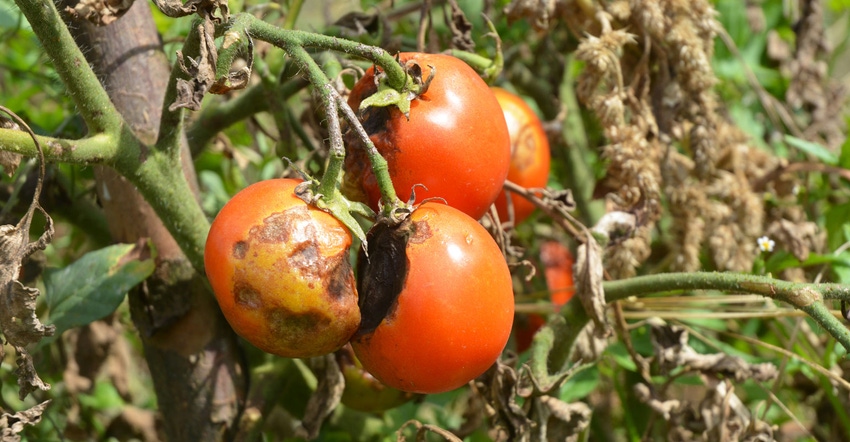April 14, 2021

Editor’s note: We asked Nebraska Extension educator Kathleen Cue, Dodge County, to dig into the details on tomato blight.
Reader question: “What are some of the common Nebraska tomato leaf blights and what can be done to mitigate them?”
Tomato blights cause rapid decline in plant health, decreasing yield. Early blight, caused by two species of Alternaria fungi, and late blight, caused by the fungal-like pathogen Phytophthora infestans are the main contributors to blight in our region.
Blights should not be confused with other fungal diseases of tomatoes, which tend to progress at a slower pace than blights. Blights spread rapidly, both within individual plants and throughout entire crops. Once blight spores contact plant tissues, full-blown infections can take place in as little as five days.
Early blight
Early blight infections occur when water droplets splash pathogens from the soil to lower parts of the plant, including stems, leaves and fruits. Once a plant is infected, the disease progresses upward.
Symptoms of early blight are concentric rings of dark tissue surrounded by a yellow halo. Fruit lesions are similar in appearance and usually occur near the stem end.
Conditions that promote disease development are temperatures ranging from 59 to 86 degrees F, rain or high humidity events, and a susceptible tomato variety. As early blight gains a foothold, reinfections occur from spread by human contact, equipment and wind.
Late blight
Late blight is caused by a fungal-like pathogen that attacks tomatoes, potatoes, peppers and eggplants during cool, wet weather later in the season. Late blight’s claim to infamy is the human starvation it caused during the Irish potato famine.
Late blight does not overwinter in soil, but it does survive winters on infected potatoes left in the soil and on infected plant debris placed in the compost pile, because warmer temperatures in compost piles help the late blight pathogen to survive.
Like early blight, late blight reinfections can occur, the most common dispersal of spores occurring from spread by rain and irrigation water. Late blight symptoms are water-soaked spots of green or brown that can sometimes have a greasy appearance. Leaves, stems and fruits are all affected.
As the disease progresses, sporulation — fruiting bodies that release spores — gives the appearance of white, fuzzy growth.
Prevention
With early and late blights, every precaution must be taken to prevent introducing pathogens into the garden, as pathogens can persist for years. Disease-free seeds and plants are a must. Fungicides containing copper or chlorothalonil may be applied preventatively to protect tomato plants grown in areas with a history of early and late blight.
Reapplying is necessary as plants grow and rainfall washes fungicides away. There are no products that will eradicate the disease from plant tissues, so removal of infected plants is critical to prevent spread.
When irrigating, keep watering can tips and garden hose ends close to the ground to minimize droplet splash. Remove affected tomatoes and plant debris from the garden. Never compost plant debris suspected of having early or late blight. Instead, infected debris can be buried, burned, or put into a clear plastic bag and placed in the sun to kill pathogens.
Learn more by emailing [email protected].
You May Also Like




